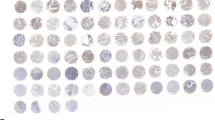Abstract
Ovarian cancer (OC) is a major cancer-related mortality among women. Recent studies suggest that many microRNAs (miRNAs) were dysregulated and involved in tumorigenesis of OC. The present study investigated the role of miR-25 in the development and progression of OC. The expression of miR-25 was increased in OC tissues and cell lines. Inhibition of miR-25 remarkably suppressed proliferation, migration, and invasion of OC cells. Large tumor suppressor 2 (LATS2), a tumor suppressor, was confirmed to be a direct target of miR-25 in OC cells. Moreover, restoration of LATS2 significantly attenuated the oncogenic effects of miR-25. Together, our data suggest an oncogenic role of miR-25 in OC and a potentially novel diagnostic and therapeutic target for OC treatment.




Similar content being viewed by others
References
Kim K, Zang R, Choi SC, Ryu SY, Kim JW. Current status of gynecological cancer in China. J Gynecol Oncol. 2009;20:72–6.
Suh DH, Kim JW, Kim K, Kim HJ, Lee KH. Major clinical research advances in gynecologic cancer in 2012. J Gynecol Oncol. 2013;24:66–82.
Siegel R, Naishadham D, Jemal A. Cancer statistics, 2013. CA Cancer J Clin. 2013;63:11–30.
Parikh A, Lee C, Peronne J, Marchini S, Baccarini A, Kolev V, et al. MicroRNA-181a has a critical role in ovarian cancer progression through the regulation of the epithelial-mesenchymal transition. Nat Commun. 2014;5:2977.
Kentwell J, Gundara JS, Sidhu SB: Noncoding RNAs in endocrine malignancy. The oncologist 2014
Alsaleh G, Gottenberg JE. Characterization of microRNAs and their targets. Methods Mol Biol. 2014;1142:55–63.
Li W, Liu Z, Chen L, Zhou L, Yao Y: MicroRNA-23b is an independent prognostic marker and suppresses ovarian cancer progression by targeting runt-related transcription factor-2. FEBS letters. 2014;588(9):1608–15.
Xia J, Guo X, Yan J, Deng K: The role of mir-148a in gastric cancer. Journal of cancer research and clinical oncology. J Cancer Res Clin Oncol. 2014;140(9):1451–56.
Li S, Li Y, Wen Z, Kong F, Guan X, Liu W. microRNA-206 overexpression inhibits cellular proliferation and invasion of estrogen receptor alphapositive ovarian cancer cells. Mol Med Rep. 2014;9:1703–8.
Shen W, Song M, Liu J, Qiu G, Li T, Hu Y, et al. Mir-26a promotes ovarian cancer proliferation and tumorigenesis. PLoS One. 2014;9:e86871.
Wang X, Meng X, Li H, Liu W, Shen S, Gao Z: MicroRNA-25 expression level is an independent prognostic factor in epithelial ovarian cancer. Clin Translational Oncol: Off Publ Federat Spanish Oncol Soc Natl Cancer Institute Mexico. Biochem Biophys Res Commun. doi:10.1007/s12094-014-1178-6.
Pecot CV, Rupaimoole R, Yang D, Akbani R, Ivan C, Lu C, et al. Tumour angiogenesis regulation by the mir-200 family. Nat Commun. 2013;4:2427.
Wang S, Zhao X, Wang J, Wen Y, Zhang L, Wang D, et al. Upregulation of microRNA-203 is associated with advanced tumor progression and poor prognosis in epithelial ovarian cancer. Med Oncol. 2013;30:681.
Xu FX, Su YL, Zhang H, Kong JY, Yu H, Qian BY. Prognostic implications for high expression of mir-25 in lung adenocarcinomas of female non-smokers. Asian Pacific J Cancer Prev: APJCP. 2014;15:1197–203.
Zhao H, Wang Y, Yang L, Jiang R, Li W. Mir-25 promotes gastric cancer cells growth and motility by targeting RECK. Mol Cell Biochem. 2014;385:207–13.
Xu X, Chen Z, Zhao X, Wang J, Ding D, Wang Z, et al. MicroRNA-25 promotes cell migration and invasion in esophageal squamous cell carcinoma. Biochem Biophys Res Commun. 2012;421:640–5.
Zhang H, Zuo Z, Lu X, Wang L, Wang H, Zhu Z. Mir-25 regulates apoptosis by targeting Bim in human ovarian cancer. Oncol Rep. 2012;27:594–8.
Yabuta N, Fujii T, Copeland NG, Gilbert DJ, Jenkins NA, Nishiguchi H, et al. Structure, expression, and chromosome mapping of LATS2, a mammalian homologue of the drosophila tumor suppressor gene lats/warts. Genomics. 2000;63:263–70.
Yu T, Bachman J, Lai ZC. Evidence for a tumor suppressor role for the large tumor suppressor genes LATS1 and LATS2 in human cancer. Genetics. 2013;195:1193–6.
Adler JJ, Johnson DE, Heller BL, Bringman LR, Ranahan WP, Conwell MD, et al. Serum deprivation inhibits the transcriptional co-activator YAP and cell growth via phosphorylation of the 130-kDa isoform of angiomotin by the LATS1/2 protein kinases. Proc Natl Acad Sci U S A. 2013;110:17368–73.
Dai X, She P, Chi F, Feng Y, Liu H, Jin D, et al. Phosphorylation of angiomotin by LATS1/2 kinases inhibits f-actin binding, cell migration, and angiogenesis. J Biol Chem. 2013;288:34041–51.
Visser S, Yang X. LATS tumor suppressor: a new governor of cellular homeostasis. Cell Cycle. 2010;9:3892–903.
Takahashi Y, Miyoshi Y, Takahata C, Irahara N, Taguchi T, Tamaki Y, et al. Down-regulation of LATS1 and LATS2 mRNA expression by promoter hypermethylation and its association with biologically aggressive phenotype in human breast cancers. Clin Cancer Res: Off J Am Assoc Cancer Res. 2005;11:1380–5.
Fang L, Du WW, Yang W, Rutnam ZJ, Peng C, Li H, et al. Mir-93 enhances angiogenesis and metastasis by targeting LATS2. Cell Cycle. 2012;11:4352–65.
Yang X, Yu J, Yin J, Xiang Q, Tang H, Lei X. Mir-195 regulates cell apoptosis of human hepatocellular carcinoma cells by targeting LATS2. Die Pharmazie. 2012;67:645–51.
Xia Y, Gao Y: MicroRNA-181b promotes ovarian cancer cell growth and invasion by targeting LATS2. Biochem Biophys Res Commun. 2014;447(3):446--51.
Conflicts of interest
None
Author information
Authors and Affiliations
Corresponding author
Rights and permissions
About this article
Cite this article
Feng, S., Pan, W., Jin, Y. et al. MiR-25 promotes ovarian cancer proliferation and motility by targeting LATS2. Tumor Biol. 35, 12339–12344 (2014). https://doi.org/10.1007/s13277-014-2546-0
Received:
Accepted:
Published:
Issue Date:
DOI: https://doi.org/10.1007/s13277-014-2546-0




